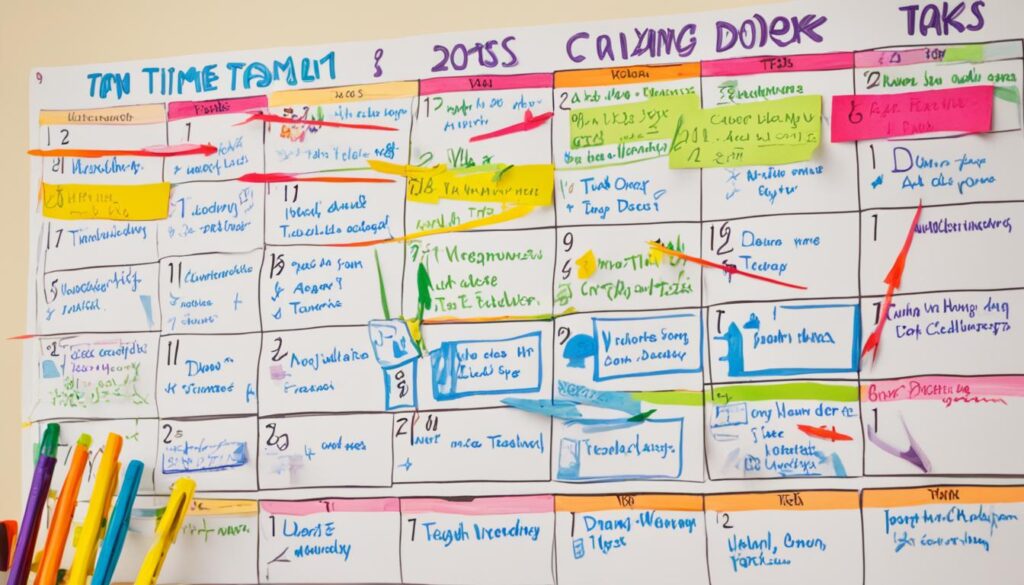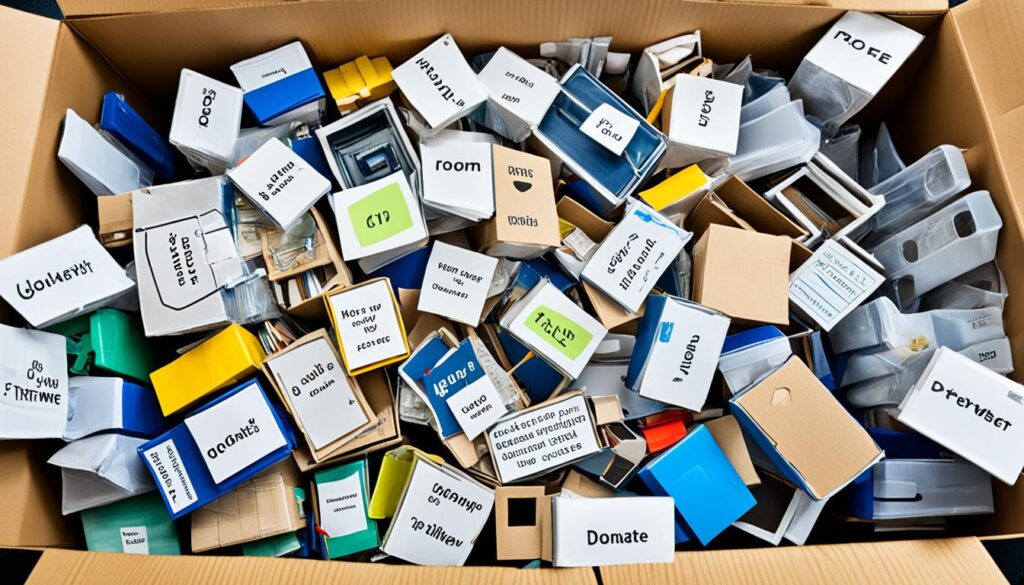Relocating to a new home can be an exciting adventure, but it can also be a daunting task. To ensure a smooth and organized move, it is essential to create a moving schedule. By carefully planning each step of the process, you can minimize stress and avoid last-minute chaos. In this article, we will guide you through the process of crafting a moving schedule that will keep you on track and make your relocation a breeze.
Whether you’re moving across town or across the country, having a well-structured plan in place can save you time, money, and a lot of headaches. A moving schedule is more than just a to-do list. It is a roadmap that helps you stay organized, prioritize tasks, and ensure that everything gets done on time.
Throughout this article, we will provide you with valuable tips and insights to help you create an effective moving schedule. From assessing your moving needs to sorting and decluttering, packing and labeling, and even handling post-move tasks, we’ve got you covered.
Key Takeaways:
- Creating a moving schedule is crucial for staying organized during the relocation process.
- A well-structured plan can save you time, money, and reduce stress.
- Assess your moving needs to determine the timeline and resources required.
- Sort and declutter your belongings before the move to streamline the process.
- Consider the pros and cons of hiring professional movers versus doing it yourself.
Why a Moving Schedule is Essential
When it comes to moving, having a clear and well-structured moving schedule is absolutely essential. Not only does it help you stay organized, but it also saves you time, money, and headaches down the road. By carefully planning out each step of your move, you can ensure that everything runs smoothly and efficiently.
One of the key benefits of a moving schedule is that it allows you to stay organized throughout the entire moving process. From the initial stages of packing up your belongings to the final stages of settling into your new home, having a schedule helps you keep track of important tasks and deadlines.
With a moving schedule, you can avoid the stress and confusion that often accompanies a disorganized move. By breaking down your move into smaller, manageable tasks, you can tackle each one step by step, ensuring that nothing gets overlooked or forgotten.
Additionally, a well-structured moving schedule can help you save time and money. By planning ahead and allowing yourself plenty of time to complete each task, you can avoid last-minute rushes and costly mistakes. For example, scheduling your moving truck well in advance can help you secure a better rate and avoid any last-minute availability issues.
Furthermore, a moving schedule allows you to prioritize important tasks. By identifying the most critical tasks and allocating sufficient time and resources to them, you can ensure that your move stays on track. This way, you can focus on what’s most important, such as packing fragile items with care or arranging for utilities to be set up in your new home.
Ultimately, a moving schedule is your roadmap to a successful and stress-free move. It helps you stay organized, saves you time and money, and allows you to prioritize tasks effectively. With a well-crafted schedule in hand, you can approach your relocation with confidence, knowing that you have thoughtfully planned out each step along the way.
Whether you’re moving across the country or just around the corner, a moving schedule is an essential tool for a smooth and successful transition. So, let’s dive into the details of creating a comprehensive moving schedule that will help you navigate the moving process with ease.
Assessing Your Moving Needs
When planning a relocation, it’s essential to assess your moving needs to ensure a smooth transition. Properly evaluating factors such as the size of your move, distance, special items, and additional services required can help you create an effective moving schedule. This assessment will provide you with valuable insights into the timeline and resources you’ll need to make your move stress-free.
To begin, determine the size of your move. Consider the number of rooms in your current home and the amount of furniture and belongings you have. This will help you estimate the time, manpower, and packing supplies necessary to complete your move.
Next, evaluate the distance of your move. Whether you’re moving locally or long-distance, the distance plays a crucial role in planning your moving schedule. Long-distance moves may require additional time and coordination, so it’s important to consider these factors when creating your timeline.
If you have any special items that require specialized handling, such as antiques, fragile artwork, or a piano, it’s crucial to account for them in your moving schedule. These items may require professional movers or specific packing techniques, which can affect the timeline and resources needed.
Additionally, consider any additional services you may require during your move. This could include packing and unpacking assistance, storage solutions, or furniture assembly. Assessing these needs early on will help you incorporate them into your moving schedule and ensure a smooth transition.
By carefully evaluating your moving needs, you can create a comprehensive moving schedule that addresses all aspects of your relocation. This will help you stay organized, avoid any last-minute surprises, and ensure a successful move to your new home.

| Factors to Consider | Considerations |
|---|---|
| Size of your move | Evaluate the number of rooms and belongings to estimate required resources. |
| Distance of your move | Determine if it’s a local or long-distance move to plan accordingly. |
| Special items | Identify any items that need specialized handling to allocate appropriate time and resources. |
| Additional services | Consider if you require assistance with packing, unpacking, storage, or furniture assembly. |
Creating a Timeline
When it comes to moving, having a well-structured timeline is essential for staying organized and ensuring a smooth transition. By breaking down your move into manageable tasks and setting realistic deadlines, you can effectively track your progress and prevent any last-minute rush. Here are some tips to help you create a timeline that keeps you on track:
- Prioritize important tasks: Start by identifying the key tasks that need to be completed before your moving day. This includes finding a moving company, notifying necessary parties, and sorting through your belongings. Prioritizing these tasks will help you allocate time and resources accordingly.
- Set realistic deadlines: Assign specific deadlines to each task based on its priority and complexity. Be sure to factor in any external dependencies, such as waiting for confirmation from utility companies or coordinating with your real estate agent. Setting realistic deadlines will prevent unnecessary stress and allow for proper planning.
- Use a calendar or moving app: Utilize a calendar or a moving app to visualize your timeline and keep yourself accountable. You can mark important dates, set reminders, and track your progress. Having a visual representation of your timeline will provide clarity and help you stay organized.
- Break down tasks: Divide larger tasks into smaller, more manageable subtasks. This will make your timeline less overwhelming and allow you to make progress incrementally. For example, instead of packing your entire house in one day, break it down into room-by-room packing sessions spread over several days.
Pro Tip: It’s important to be flexible with your timeline, as unforeseen circumstances may arise. Give yourself some buffer time to accommodate any unexpected delays or changes that may occur during the moving process.

By creating a comprehensive timeline for your move, you can stay organized, alleviate stress, and ensure a successful relocation. Remember to adjust your timeline as needed and be proactive in tackling tasks. Stay tuned for the next section, where we will discuss effective strategies for sorting and decluttering your belongings before the move.
Sorting and Decluttering
When it comes to moving, decluttering is a crucial step in ensuring an organized and efficient relocation process. Before you start packing up your belongings, it’s important to take the time to sort through them and decide what items you truly need to bring with you to your new home. By decluttering, you can reduce the number of items you need to pack, save on moving costs, and create a more organized living space.
Here are some effective strategies to help you declutter before your move:
- Sort items: Begin by categorizing your belongings into different groups such as “keep,” “donate,” and “sell.” This will make the decision-making process easier and allow you to prioritize what needs to be packed.
- Decide what to keep: Consider the value and usefulness of each item. Ask yourself if you’ve used it in the past year or if it holds sentimental value. If the answer is no, it may be time to let go.
- Donate or sell: Items that are still in good condition but no longer serve a purpose for you can be donated to charities or sold online. This not only helps you declutter but also benefits others.
By following these tips, you can declutter your home and create a fresh start in your new space. Remember, the less you have to pack, the easier and more organized your move will be.
Here’s a helpful quote to keep in mind during the decluttering process:
“The more you have, the more you are occupied. The less you have, the more free you are.” – Mother Teresa
Decluttering Checklist
| Category | Action |
|---|---|
| Clothing | Go through each item and donate or sell anything you no longer wear or need. |
| Household Items | Assess your kitchenware, decor, and other household items. Let go of anything you don’t use or love. |
| Furniture | Determine if any furniture pieces are worth moving. Consider their condition and whether they fit in your new space. |
| Paperwork | Sort through important documents and shred any outdated or unnecessary paperwork. |
| Electronics | Dispose of old or broken electronics responsibly. Consider recycling or donating if appropriate. |
Remember, decluttering is an ongoing process. Start early and give yourself plenty of time to make thoughtful decisions about what to keep and what to let go of. By doing so, you’ll enjoy a more organized and stress-free move.

Hiring Professional Movers or DIY?
If you’re preparing for a move, one of the important decisions you’ll need to make is whether to hire professional movers or handle the relocation yourself. Each option has its pros and cons, and your choice will depend on your specific circumstances and budget. Let’s explore the factors to consider when making this decision:
Pros of Hiring Professional Movers
- Convenience: Professional movers take care of all the heavy lifting, packing, and transportation, saving you time and effort.
- Expertise: Experienced movers have the necessary knowledge and skills to handle fragile items, navigate stairs and narrow hallways, and ensure the safe transport of your belongings.
- Insurance coverage: Most professional moving companies offer insurance options, providing you with peace of mind in case of any damages or losses during the move.
- Efficiency: Movers are efficient in their work, ensuring a faster and more organized relocation process.
Cons of Hiring Professional Movers
- Cost: Hiring professional movers can be more expensive compared to a DIY move, especially if you have a limited budget.
- Lack of control: When you hire movers, you may have less control over the process, such as the packing and handling of your belongings.
- Rigid schedules: Professional movers may have limited availability, and you’ll need to align your moving schedule with their availability.
Pros of DIY Move
- Cost savings: Moving yourself can be cheaper as you won’t have to pay for professional services.
- Control: You have complete control over every aspect of the move, from packing to transportation.
- Flexibility: DIY moves allow you to set your own schedule and timeline, giving you more flexibility.
Cons of DIY Move
- Physical labor: Moving involves heavy lifting, which can be physically demanding and potentially lead to injuries if not done properly.
- Lack of expertise: Without professional experience, you may face challenges in safely packing and transporting delicate or bulky items.
- Time-consuming: DIY moves require a significant amount of time and effort, particularly if you’re moving a large household or long distance.
Ultimately, the decision between hiring professional movers or doing it yourself depends on your individual needs, budget, and the complexity of your move. Assess your situation carefully and consider the factors highlighted above to make the right choice for a smooth and successful relocation.
“Whether you opt for professional movers or a DIY move, creating a well-structured moving schedule is crucial for staying organized and minimizing stress.”

| Factors | Hiring Professional Movers | DIY Move |
|---|---|---|
| Cost | Higher initial cost, but potential savings in time and effort | Lower cost, but may require more time and physical labor |
| Convenience | Convenient and time-saving, less physical labor | Requires personal effort and physical labor |
| Control | Less control over the process | Full control over every aspect of the move |
| Expertise | Professional skills and experience | May require research and learning |
| Insurance | Potential insurance coverage for damages or losses | No insurance coverage unless self-arranged |
| Flexibility | May need to align with movers’ availability | Flexible schedule and timeline |
Packing and Labeling
When it comes to moving, efficient packing and proper labeling can make a world of difference in streamlining the process. Follow these practical tips to stay organized and ensure a smooth transition to your new home.
Pack strategically
Start by gathering all the packing supplies you’ll need, including boxes, packing tape, bubble wrap, and markers. Sort your belongings into categories and pack similar items together. This will make unpacking and finding specific items much easier later on. Remember to label boxes with fragile items so that they receive extra care during transportation.
Use a labeling system
An effective labeling system is essential for an organized move. Assign each box a number or a letter and create a corresponding inventory list. Write down the contents of each box on the list and label the box accordingly. This will help you locate items quickly and efficiently when unpacking. Consider color-coding your labels by room to further simplify the process.
“Proper labeling is the key to stress-free unpacking. Take the time to label each box accurately, and you’ll thank yourself later.”
Label essentials separately
Set aside a box or bag for essential items that you’ll need immediately upon arriving at your new home. This may include toiletries, a change of clothes, important documents, and basic kitchen supplies. Label this box as “Essentials” or “Open First” and keep it easily accessible so that you can quickly locate these crucial items in the midst of unpacking.
| Tips for Packing and Labeling |
|---|
| 1. Use sturdy boxes and secure them with packing tape. |
| 2. Clearly label each box with its contents and destination room. |
| 3. Take photos of complicated electronics setups before disconnecting. |
| 4. Pack heavy items in smaller boxes to avoid strain or damage. |
| 5. Fill empty spaces in boxes with packing paper to prevent shifting. |
| 6. Label fragile items with extra care and use cushioning materials. |
By packing strategically, utilizing a reliable labeling system, and organizing your essential items separately, you’ll be well-prepared for a seamless unpacking process. Keep these tips in mind as you pack for your move, and enjoy a hassle-free transition to your new home.
Notifying Important Parties
When it comes to moving, notifying the right parties is crucial to ensure a smooth transition to your new home. By taking the time to inform important contacts about your relocation, you can avoid potential issues and stay organized throughout the moving process.
Here are some key parties you should consider notifying:
- Utilities: Contact your utility providers, such as electricity, gas, water, and internet providers, to schedule disconnection at your current address and connection at your new location. This will prevent any service interruptions and make sure you have essential utilities up and running in your new home.
- Schools: If you have children, notify their schools about the upcoming move. Arrange for their academic records and transcripts to be transferred to their new school. This will help facilitate a smooth transition for your children and ensure continuity in their education.
- Healthcare providers: Inform your doctors, dentists, and other healthcare professionals about your relocation. Request copies of your medical records, prescriptions, and any ongoing treatment plans. Additionally, research healthcare providers in your new area and transfer your records to them, ensuring continuity of care.
- Postal service: Submit a Change of Address request with the United States Postal Service (USPS) to have your mail forwarded to your new address. This will help you receive important documents, bills, and subscriptions without interruption.
- Financial institutions: Notify your bank, credit card companies, and any other financial institutions about your change of address. Update your mailing address, so you can continue to receive statements, cards, and important financial notifications.
- Insurance providers: Contact your insurance providers for home insurance, car insurance, healthcare insurance, and any other policies. Update your address and provide them with your new contact information to ensure continued coverage.
Remember, it’s essential to notify these parties well in advance of your moving date. Make a list and allocate time to contact each one, ensuring a smooth transition to your new home. By being proactive and organized, you can minimize potential disruptions and start enjoying your new space as quickly as possible.
Moving Day Essentials
On the big day, it’s crucial to have all the necessary items and supplies at your fingertips. Being prepared will help you navigate any unexpected challenges that may arise during your move. Here’s a checklist of moving day essentials:
- Packing Supplies: Make sure you have an ample supply of boxes, tape, bubble wrap, and other packing materials to secure your belongings for transport.
- Basic Tools: Keep a toolbox handy with essential tools like a screwdriver, hammer, utility knife, and a flashlight. These tools will come in handy for assembling furniture, fixing any last-minute issues, or addressing unforeseen problems.
- Moving Equipment: If you’re moving heavy furniture or appliances, consider renting or purchasing moving equipment such as dollies, hand trucks, or furniture sliders to make the process easier and avoid any injuries.
- Cleaning Supplies: Before leaving your old place, make sure you have cleaning supplies like brooms, mops, all-purpose cleaners, and paper towels to give it a thorough clean. Similarly, keep cleaning supplies on hand for your new home to give it a quick once-over if needed.
- Personal Essentials: Pack a bag with toiletries, medication, a change of clothes, and any necessary documents or important paperwork that you may need immediate access to upon arrival at your new home. This will save you from rummaging through boxes and allow you to freshen up and settle in comfortably.
- Snacks and Beverages: Moving day can be tiring, so don’t forget to pack snacks, bottled water, and other beverages to keep you energized and hydrated throughout the day. This will help you avoid unnecessary breaks and stay on schedule.
Remember, the key is to anticipate your needs and have everything organized in advance. By having these essential items readily available, you’ll be better equipped to tackle any challenges that come your way on moving day.
Unpacking and Settling In
After a long and exhausting moving process, you’ve finally arrived at your new home. Now it’s time to unpack and turn this unfamiliar place into your own cozy sanctuary.
Unpacking efficiently is key to getting settled in quickly. Follow these tips to stay organized and make the most of your moving schedule:
1. Start with essentials
Begin by unpacking the essentials you’ll need immediately, such as toiletries, bedding, and kitchen supplies. This way, you can comfortably settle in while gradually unpacking the rest of your belongings.
2. Create an unpacking plan
Develop an unpacking plan to stay organized. Start with one room at a time, working from the most important to the least important areas. This way, you can focus on creating functional spaces and feel a sense of accomplishment as you complete each room.
3. Group items by category
To streamline the unpacking process, group similar items together. Keep kitchenware together, bedroom items together, and so on. This will make it easier to find what you need when you’re settling in.
4. Use proper labeling
Ensure you labeled your boxes during the packing phase. If not, take the time to label them now. Clearly mark each box with the room it belongs to and a brief description of its contents. This will save you time and effort when unpacking and organizing your new space.
5. Declutter as you unpack
As you unpack, take the opportunity to declutter further. If you come across items that you no longer need or that don’t fit your new space, consider donating or selling them. This will help you create a fresh and clutter-free environment.
Remember, moving is a process, and settling in takes time. Take breaks, celebrate small victories, and make your new house feel like home one room at a time.
Now, let’s take a moment to visualize your new home:
| ITEM | DESCRIPTION |
|---|---|
| Boxes | Unpack one room at a time, starting with essentials |
| Labels | Clearly mark boxes with room names and contents |
| Decluttering | Donate or sell items you no longer need |
Handling Post-Move Tasks
Congratulations on completing your move! While the hard part may be over, there are still a few essential tasks you need to take care of to ensure a smooth transition. By handling these post-move tasks promptly, you can settle into your new home comfortably. Here are the important tasks to prioritize:
1. Update your address
Don’t forget to update your address with the necessary parties. Contact the post office to forward your mail for a designated period, update your address with the DMV, and notify your bank, credit card companies, and any subscription services you use. This will ensure you receive your mail and important documents without any delays.
2. Transfer utilities
Contact your utility providers, such as gas, water, electricity, internet, and cable companies, to transfer or set up new services at your new address. Schedule the disconnection of utilities at your previous property to avoid any unnecessary charges.
3. Forward important documents
If you have any ongoing legal matters or important documents stored with your attorney, accountant, or other professionals, make sure to inform them about your new address. This includes any insurance policies, medical records, and legal documents that may need to be updated or transferred.
4. Register your vehicle
If you’ve moved to a new state, research the requirements for registering your vehicle. This may include updating your driver’s license and vehicle registration within a specific timeframe.
5. Research local services
Take some time to familiarize yourself with your new neighborhood. Research and find new service providers such as doctors, dentists, veterinarians, and other essential services. This will help you feel more settled and prepared for any unforeseen circumstances.
| Task | Status |
|---|---|
| Update address with post office | In Progress |
| Transfer utilities | Not Started |
| Forward important documents | Completed |
| Register vehicle | In Progress |
| Research local services | Not Started |
As you tackle these post-move tasks, remember to take your time and prioritize your needs. Every relocation is unique, so adjust the list based on your personal circumstances and requirements. By staying organized and addressing these tasks promptly, you can settle into your new home smoothly and enjoy the beginning of your new chapter.
Conclusion
In conclusion, creating a well-structured moving schedule is crucial for a smooth and stress-free relocation. By following the tips and insights provided in this article, you can stay organized and on track throughout your move.
Start by assessing your moving needs and creating a detailed timeline. This will help you prioritize tasks, set realistic deadlines, and allocate sufficient resources. Don’t forget to sort and declutter your belongings before packing, as this will streamline the process and save you time and effort.
Whether you decide to hire professional movers or opt for a DIY approach, remember to pack and label your belongings strategically. This will make unpacking easier and ensure that everything arrives at your new home unscathed.
Lastly, be sure to notify important parties and have essential items on hand for moving day. Once you’ve arrived in your new home, take the time to unpack efficiently and get settled in. Don’t forget about post-move tasks such as updating your address and transferring utilities.
For more information, assistance, or to explore our services, visit unitedmovingmanagement.com.



